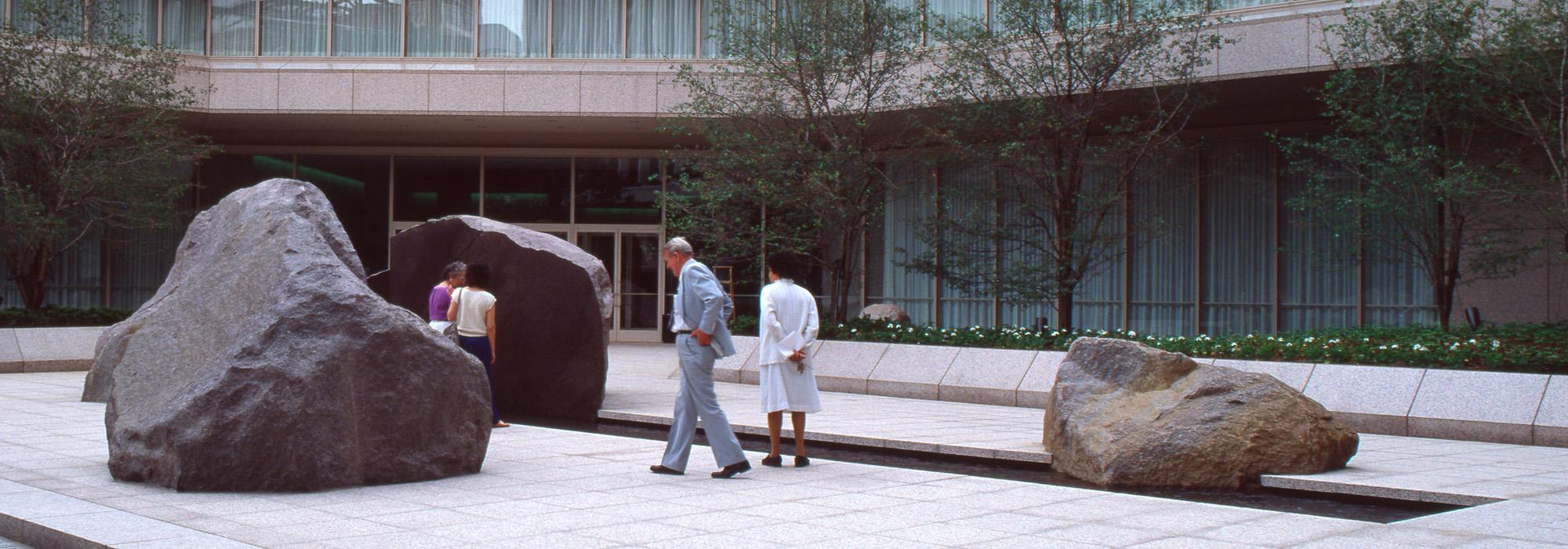Sculptural installation MARABAR, by artist Elyn Zimmerman, at National Geographic Society headquarters is threatened with demolition and designated a Landslide site
Media Contact: Nord Wennerstrom | T: 202.483.0553 | M: 202.225.7076 | E: nord@tclf.org
Site-specific installation is widely considered to be the artist’s most influential work
Washington, D.C. (March 31, 2020) – The Cultural Landscape Foundation (TCLF) today designated the sculptural installation MARABAR by New York-based artist Elyn Zimmerman, located at the National Geographic Society headquarters in Washington, D.C., and currently threatened with demolition, as a Landslide site. Landslide is one of TCLF’s four core programs and brings attention to nationally significant landscapes and landscape features that are threatened and at-risk. The program has been instrumental in preventing the demolition of many important sites. MARABAR, completed in 1984, was commissioned by National Geographic and is sited in a centrally located, publicly accessible plaza on the organization’s campus. As detailed in the Landslide designation, a proposed redesign of the plaza would destroy Zimmerman’s sculpture.
“National Geographic is one of the world’s leading champions of cultural awareness, so its plan to demolish a significant work of art under its stewardship is especially disconcerting,” said Charles A. Birnbaum, TCLF’s president and CEO. “Sadly, this is part of a trend in which cultural institutions ironically prove to be a threat to designed landscapes and landscape features in their collections.”
MARABAR was Zimmerman’s first large-scale and (ostensibly) permanent project. She received the commission not long after returning to the United States from India—a journey that marked her transition from being primarily a photographer and painter to a sculptor and environmental artist. The focal point of MARABAR is a rectangular reflecting pool (6 x 60 ft.) set amid five mahogany-colored granite boulders, three of which have highly polished and reflective surfaces, mirroring one another across the pool. The massive stones are deliberately shaped, having been sheared along natural cleft lines, their forms and positions alluding to some seismic event that has lacerated the plaza to reveal a natural spring. Because the boulders sink below the granite pavement, which also hovers above the water in the pool, the plaza's natural elements appear to antedate the man-made construction. Seven other boulders are strategically sited throughout the nearby gardens, creating individual moments of discovery and a dialogue with the pool ensemble. The title of the piece, bestowed after it was completed, derives from the fictional Marabar Caves (based on the real Barabar Caves outside the City of Gaya) in E.M. Forster’s A Passage to India.
In July 2019, National Geographic filed plans for approval by the District of Columbia’s Historic Preservation Review Board (HPRB), seeking to “unify the existing national geographic campus with a new pavilion, plaza, renovated ground level, and cohesive streetscape.” Although the HPRB approved the plans by a 7-0 vote in August 2019, it is as yet unclear whether the review board was made aware of the sculpture’s presence in the plaza, or of its significance. The renderings of the site, as presented to the review board, did not label or otherwise identify the work of art.
The project is currently under review by the District of Columbia’s Department of Consumer and Regulatory Affairs, whose stamp of approval is necessary to obtain building permits. TCLF is asking the HPRB to revisit the plans for the new pavilion in order to take a full account of its effect on the sculpture. Members of the public are urged to contact the HPRB, too.
About Elyn Zimmerman
Elyn Zimmerman’s work is featured in the collections of the Museum of Modern Art, the Whitney Museum of America Art, and the Los Angeles County Museum of Art, for example, and it has been recognized by awards from the Art Commission of the City of New York, the National Endowment for the Arts, and the Maryland chapter of the American Society of Landscape Architects. Among her many large-scale public projects are commissions from the Institute for Advanced Studies, in Princeton, New Jersey; the Sydney and Walda Besthoff Sculpture Garden at the New Orleans Museum of Art; the U.S. State Department for the embassy in Dar es Salaam, Tanzania; and the Vancouver Art Commission for a prominent project in the city center.
Zimmerman served as a member of the U.S. Commission of Fine Arts from 2003 to 2008, and in 2016 she, along with Tadao Ando, received the Isamu Noguchi Award, given annually to practitioners who “share Noguchi’s spirit of innovation, global consciousness, and East-West exchange.”
For additional information, TCLF has published a conversation with Elyn Zimmerman.
About The Cultural Landscape Foundation
The Cultural Landscape Foundation (TCLF) is a 501(c)(3) non-profit founded in 1998 to connect people to places. TCLF educates and engages the public to make our shared landscape heritage more visible, identify its value, and empower its stewards. Through its website, publishing, lectures, and other events, TCLF broadens support and understanding for cultural landscapes. TCLF is also home to the Cornelia Hahn Oberlander International Landscape Architecture Prize.
# # #



